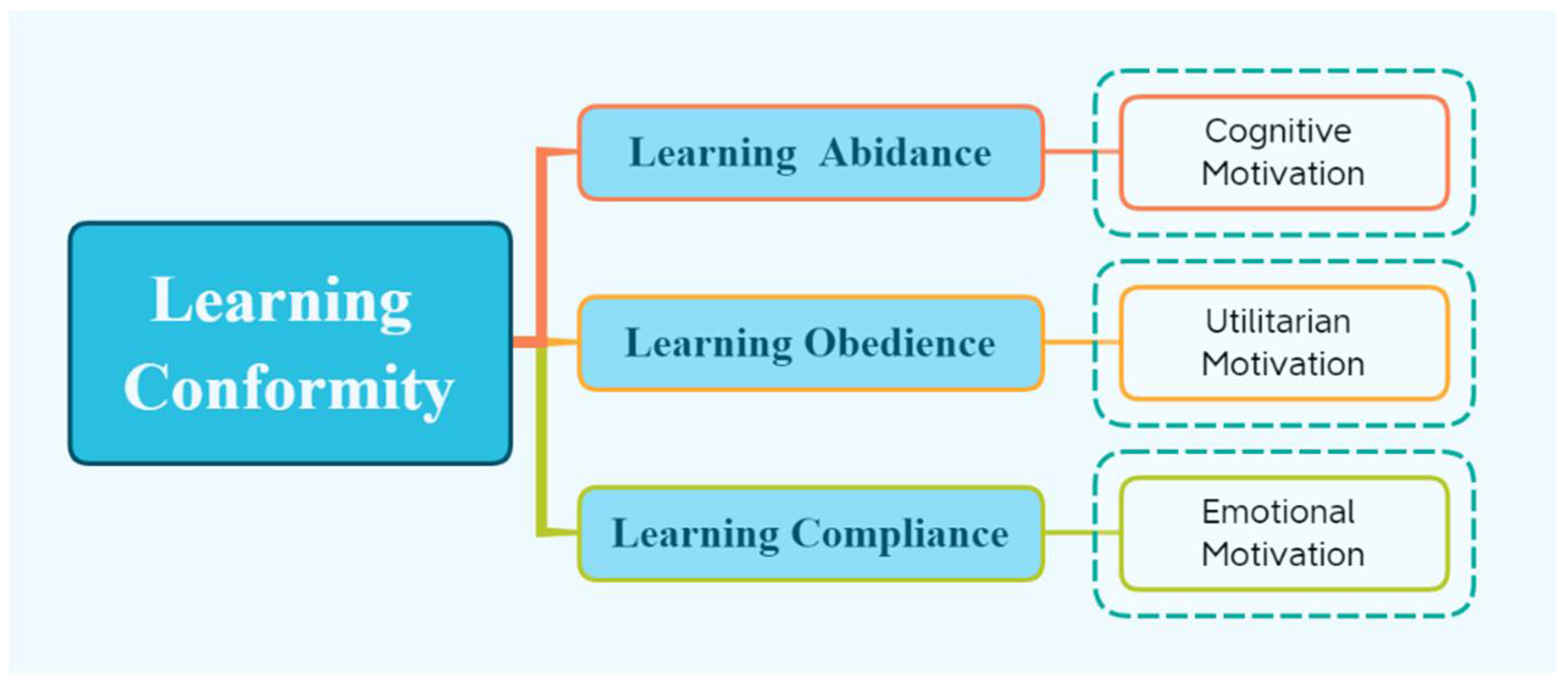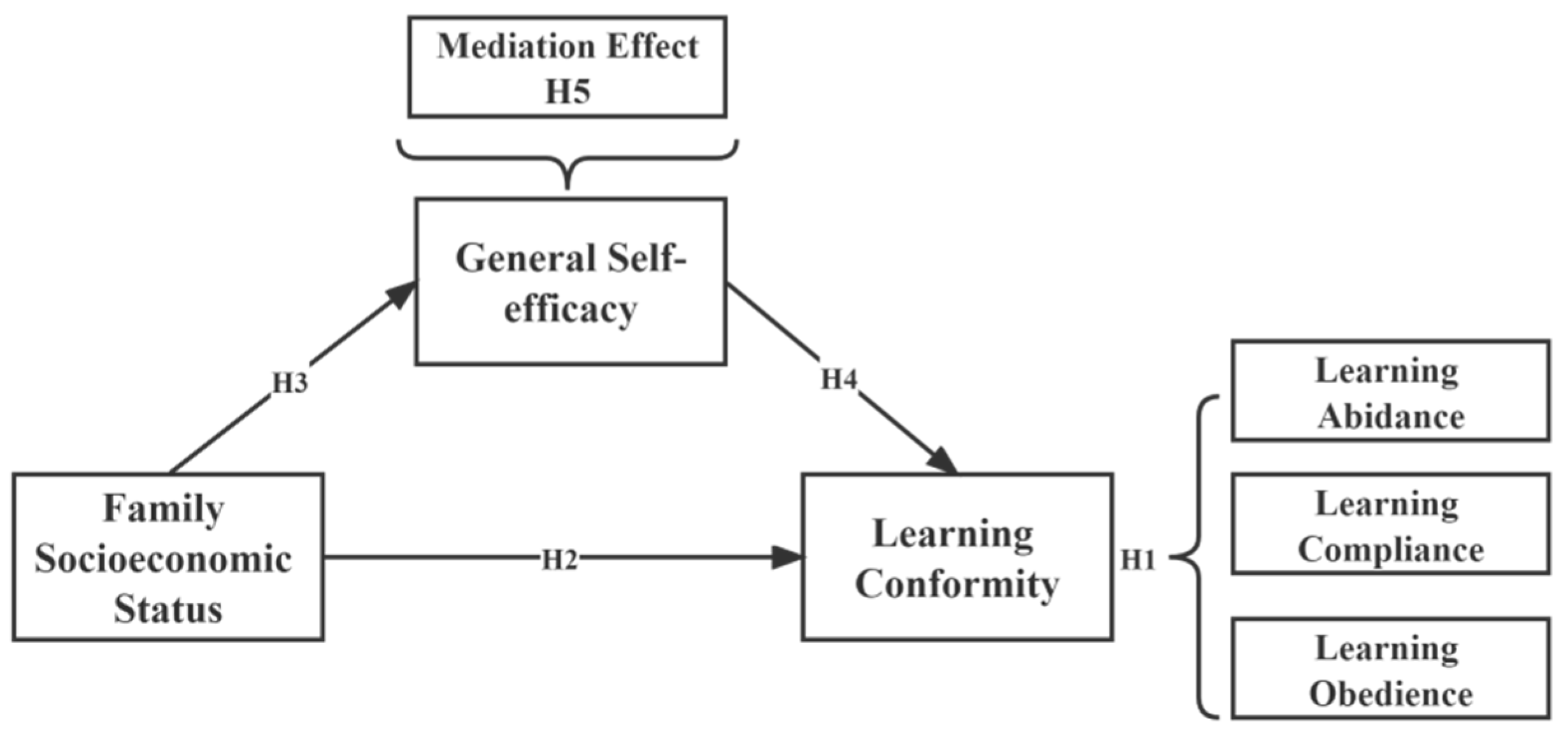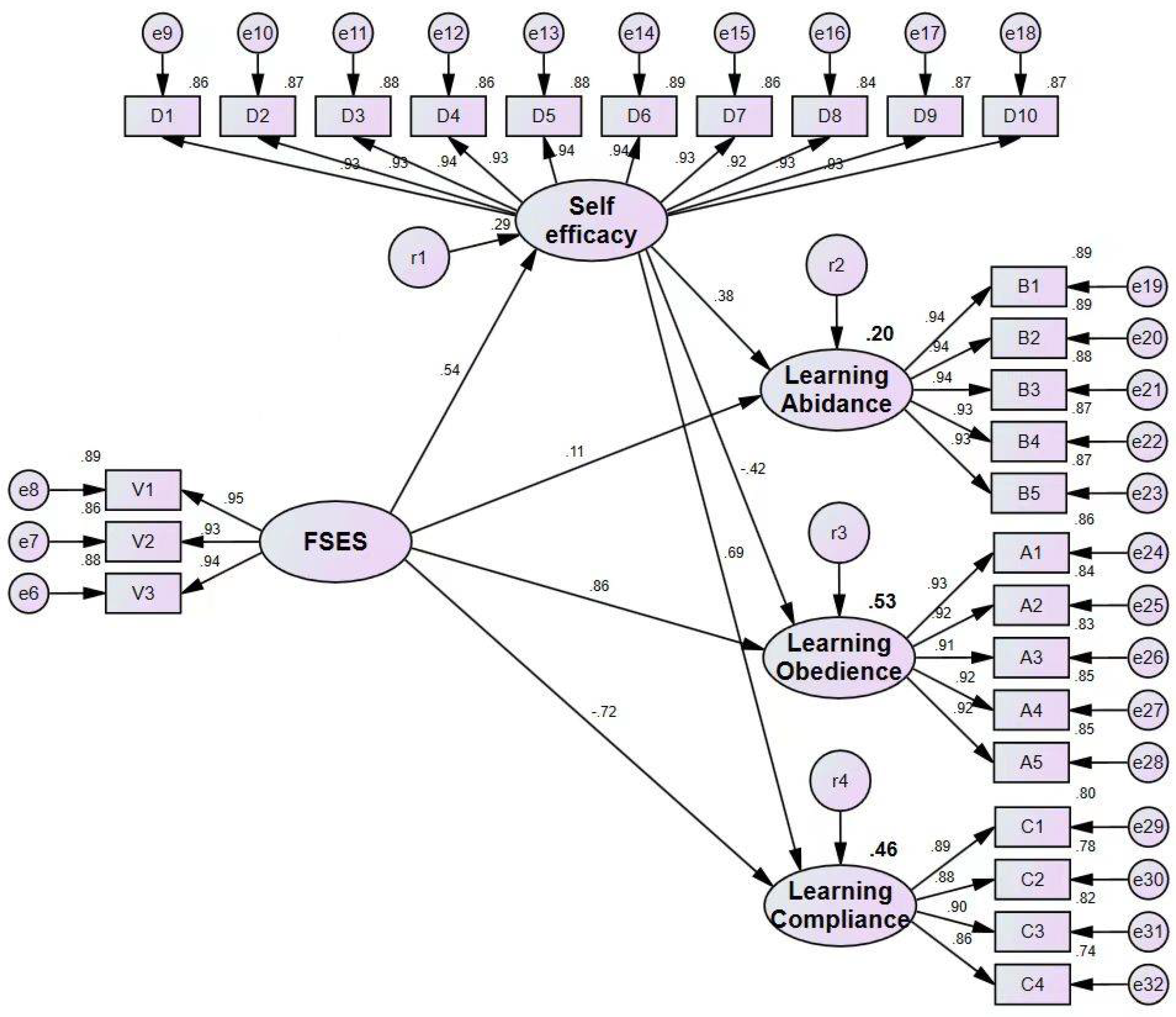The Impact of Family Socioeconomic Status on Learning Conformity among Chinese University Students: Self-Efficacy as Mediating Factor
Abstract
:1. Introduction
2. Literature Review and Research Hypothesis
2.1. Learning Conformity Can Categorize into Three Types Based on Learning Motivation
2.2. The Effect of Family Socioeconomic Status on Learning Conformity
2.3. Mediating Effects of General Self-Efficacy
3. Materials and Methods
3.1. Participants and Procedures
3.2. Measures
3.2.1. Learning Conformity Scale
3.2.2. Family Socioeconomic Status Questionnaire
3.2.3. General Self-Efficacy Scale
3.3. Statistical Analysis
4. Results
4.1. Common Method Bias
4.2. Preliminary Analysis
4.3. The Structural Equation Model
4.4. Significance Tests for Mediation Effects
5. Discussion
5.1. Explore and Validate the Classification of Learning Conformity
5.2. Differential Performance of Correlation Analysis
5.3. The Effect of Family Socioeconomic Status on Learning Conformity
5.4. Mediating Effects of General Self-Efficacy
6. Limitations
7. Conclusions
Author Contributions
Funding
Institutional Review Board Statement
Informed Consent Statement
Data Availability Statement
Conflicts of Interest
References
- Liu, T.; Lipowski, M. Sports Gamification: Evaluation of Its Impact on Learning Motivation and Performance in Higher Education. Int. J. Environ. Res Public Health 2021, 18, 1267. [Google Scholar] [CrossRef] [PubMed]
- von Suchodoletz, A.; Rahn, J.; Nadyukova, I.; Barza, L.; Achtziger, A. Can mindsets influence college students’ motivation to learn? Findings from the United States and the United Arab Emirates. High. Educ. 2019, 79, 731–748. [Google Scholar] [CrossRef]
- Kai, Y.; Zhujun, K.; Zhijie, C.; Xiaoting, S.; Wanyue, T. Social learning? Conformity? Or comparison?—An empirical study on the impact of peer effects on Chinese seniors’ intention to purchase travel insurance. Tour. Manag. Perspect. 2021, 38, 100809. [Google Scholar] [CrossRef]
- Adam, S. The Theory of Moral Sentiments; Raphael, D.D., Macfie, A.L., Eds.; Oxford University Press: Oxford, UK, 1759. [Google Scholar] [CrossRef]
- Sherif, M. An experimental approach to the study of attitudes. Sociometry 1937, 1, 90–98. [Google Scholar] [CrossRef]
- Asch, S.E. Opinions and social pressure. Sci. Am. 1955, 193, 31–35. [Google Scholar] [CrossRef]
- Asch, S.E. Studies of independence and conformity: I.A minority of one against a unanimous majority. Psychol. Monogr. Gen. Appl. 1956, 70, 1–70. [Google Scholar] [CrossRef] [Green Version]
- Moscovici, S.; Lage, E.; Naffrechoux, M. Influence of a consistent minority on the responses of a majority in a color perception task. Sociometry 1969, 32, 365–380. [Google Scholar] [CrossRef] [PubMed] [Green Version]
- Song, G.; Wang, S. Process and attribution analysis of social conformity. Social sciences and Interdisciplinary Behavior. In Proceedings of the 4th International Congress on Interdisciplinary Behavior and Social Science, ICIBSOS 2015, Jakarta, Indonesia, 7–8 November 2015; pp. 72–79. [Google Scholar] [CrossRef]
- Zhao, X.J.; Liu, M.Z.; Liu, Y.Q. The Influence of Different Learning Strategies on Pupils’ Learning Motivation: Is Augmented Reality Multimedia Learning Consistent With Traditional Text Learning? Front. Psychol. 2022, 13, 810345. [Google Scholar] [CrossRef] [PubMed]
- Van Thac, D.; Chou, Y.-C. Extrinsic motivation, workplace learning, employer trust, self-efficacy and cross-cultural adjustment An empirical study of Vietnamese laborers in Taiwan. Pers. Rev. 2020, 49, 1232–1253. [Google Scholar] [CrossRef]
- Aguilar, S.J.; Karabenick, S.A.; Teasley, S.D.; Baek, C. Associations between learning analytics dashboard exposure and motivation and self-regulated learning. Comput. Educ. 2021, 162, 104085. [Google Scholar] [CrossRef]
- Kim, Y.-e.; Brady, A.C.; Wolters, C.A. College students’ regulation of cognition, motivation, behavior, and context: Distinct or overlapping processes? Learn. Individ. Differ. 2020, 80, 101872. [Google Scholar] [CrossRef]
- An, Y.; Li, L.; Wei, X. What influences teachers’ self-efficacy in East Asia? Evidence from the 2018 Teaching and Learning International Survey. Soc. Behav. Personal. 2021, 49, 13. [Google Scholar] [CrossRef]
- Johnston, B.M. Conquering with capital: Social, cultural, and economic capital’s role in combating socioeconomic disadvantage and contributing to educational attainment. J. Youth Stud. 2018, 21, 590–606. [Google Scholar] [CrossRef]
- Chen, S.H.; Zhou, Q. Cultural Values, Social Status, and Chinese American Immigrant Parents’ Emotional Expressivity. J. Cross-Cult. Psychol. 2019, 50, 381–395. [Google Scholar] [CrossRef] [PubMed]
- Xu, X.; Xia, M.; Pang, W. Family socioeconomic status and Chinese high school students’ test anxiety: Serial mediating role of parental psychological control, learning resources, and student academic self-efficacy. Scand J. Psychol. 2021, 62, 689–698. [Google Scholar] [CrossRef]
- Reardon, R.C.; Lenz, J.G.; Sampson, J.P., Jr.; Peterson, G.W. Big Questions Facing Vocational Psychology: A Cognitive Information Processing Perspective. J. Career Assess. 2011, 19, 240–250. [Google Scholar] [CrossRef]
- Syrjamaki, A.H.; Hietanen, J.K. The effects of social exclusion on processing of social information—A cognitive psychology perspective. Br. J. Soc. Psychol. 2019, 58, 730–748. [Google Scholar] [CrossRef] [Green Version]
- Xiong, A.; Proctor, R.W. Information Processing: The Language and Analytical Tools for Cognitive Psychology in the Information Age. Front. Psychol. 2018, 9, 1270. [Google Scholar] [CrossRef] [PubMed]
- Xiao, B.; Song, G. Association between Self-Efficacy and Learning Conformity among Chinese University Students: Differences by Gender. Sustainability 2022, 14, 8725. [Google Scholar] [CrossRef]
- Song, G. Recognition of Herd Behavior. Psychol. Sci. 2002, 25, 202–204. [Google Scholar] [CrossRef]
- Song, G.; Ma, Q.; Wu, F.; Li, L. The Psychological Explanation of conformity. Soc. Behav. Personal. 2012, 40, 1365–1372. [Google Scholar] [CrossRef]
- Masland, L.C.; Lease, A.M. Effects of achievement motivation, social identity, and peer group norms on academic conformity. Soc. Psychol. Educ. 2013, 16, 661–681. [Google Scholar] [CrossRef]
- Pascual, A.; Felonneau, M.L.; Guéguen, N.; Lafaille, E. Conformity, obedience to authority, and compliance without pressure to control cigarette butt pollution. Soc. Influ. 2014, 9, 83–98. [Google Scholar] [CrossRef]
- Hollebeek, L.D.; Sprott, D.E.; Sigurdsson, V.; Clark, M.K. Social influence and stakeholder engagement behavior conformity, compliance, and reactance. Psychol. Mark. 2022, 39, 90–100. [Google Scholar] [CrossRef]
- Karen, A.M.; Linda, C.G. Psychological Perspectives on Pathways Linking Socioeconomic Status and Physical Health. Annu. Rev. Psychol. 2011, 62, 501–530. [Google Scholar] [CrossRef] [Green Version]
- Chen, Q.; Kong, Y.; Gao, W.; Mo, L. Effects of Socioeconomic Status, Parent-Child Relationship, and Learning Motivation on Reading Ability. Front. Psychol. 2018, 9, 1297. [Google Scholar] [CrossRef]
- Wen, N.; Guo, W. “Toxic friends”? The farther away, the less stressful: The impact of social distance to a dissociative group on consumer choices. Eur. J. Mark. 2021, 55, 925–943. [Google Scholar] [CrossRef]
- Tucker-Drob, E.M.; Harden, K.P. Learning Motivation Mediates Gene-by-Socioeconomic Status Interaction on Mathematics Achievement in Early Childhood. Learn. Individ. Differ. 2012, 22, 37–45. [Google Scholar] [CrossRef] [Green Version]
- Bradstreet, T.C.; Parent, M.C. To Be (Healthy) or Not to Be: Moderated Mediation of the Relationships Between Masculine Norms, Future Orientation, Family Income, and College Men’s Healthful Behaviors. Psychol. Men Masc. 2018, 19, 500–511. [Google Scholar] [CrossRef]
- King, R.B.; Trinidad, J.E. Growth mindset predicts achievement only among rich students: Examining the interplay between mindset and socioeconomic status. Soc. Psychol. Educ. 2021, 24, 635–652. [Google Scholar] [CrossRef]
- Ishihara, T.; Morita, N.; Nakajima, T.; Okita, K.; Sagawa, M.; Yamatsu, K. Modeling relationships of achievement motivation and physical fitness with academic performance in Japanese schoolchildren: Moderation by gender. Physiol. Behav. 2018, 194, 66–72. [Google Scholar] [CrossRef]
- Bandura, A. Social Foundations of Thought and Action; SAGE Publications Ltd.: Thousand Oaks, CA, USA, 2002. [Google Scholar]
- Bong, M.; Clark, R.E. Comparison between self-concept and self-efficacy in academic motivation research. Educ. Psychol. 1999, 34, 139–153. [Google Scholar] [CrossRef]
- Shilenkova, L.N. Self-efficacy in the educational process (review of foreign studies). Sovrem. Zarubežnaâ Psihol. 2020, 9, 69–72. [Google Scholar] [CrossRef]
- Bian, F.; Wu, D. The impact of family socioeconomic status on prosocial behavior: A survey of college students in China. Curr. Psychol. 2021. [Google Scholar] [CrossRef]
- Kasser, T.; Koestner, R.; Lekes, N. Early family experiences and adult values: A 26-year, prospective longitudinal study. Personal. Soc. Psychol. Bull. 2002, 28, 826–835. [Google Scholar] [CrossRef] [Green Version]
- Shukla, K.D.; Kuril, S.; Chand, V.S. Does negative teacher behavior influence student self-efficacy and mastery goal orientation? Learn. Motiv. 2020, 71, 101653. [Google Scholar] [CrossRef]
- China, N.B.O.S. China Statistical Yearbook; China Statistic Press: Beijing, China, 2010. [Google Scholar]
- Sun, J.C.-Y.; Syu, Y.-R.; Lin, Y.-Y. Effects of conformity and learning anxiety on intrinsic and extrinsic motivation: The case of Facebook course groups. Univers. Access Inf. Soc. 2016, 16, 273–288. [Google Scholar] [CrossRef]
- Kaiser, H.F. An index of factorial simplicity. Psychometrika 1974, 39, 31–36. [Google Scholar] [CrossRef]
- Tucker, L. Psychometric theory: General and specific. Psychometrika 1955, 20, 267–271. [Google Scholar] [CrossRef]
- Hu, L.-T.; Bentler, P.M. Cutoff criteria for fit indexes in covariance structure analysis: Conventional criteria versus new alternatives. Struct. Equ. Modeling 1999, 6, 1–55. [Google Scholar] [CrossRef]
- Bradley, R.H.; Corwyn, R.F. Socioeconomic status and child development. Annu. Rev. Psychol. 2002, 53, 371–399. [Google Scholar] [CrossRef] [Green Version]
- Schwarzer, R.; Mueller, J.; Greenglass, E. Assessment of perceived general self-efficacy on the internet: Data collection in cyberspace. Anxiety Stress Coping 1999, 12, 145–161. [Google Scholar] [CrossRef]
- Preacher, K.J.; Hayes, A.F. Asymptotic and resampling strategies for assessing and comparing indirect effects in multiple mediator models. Behav. Res. Methods 2008, 40, 879–891. [Google Scholar] [CrossRef]
- Bandura, A. Self-efficacy: Toward a unifying theory of behavioral change. Psychol. Rev. 1977, 84, 191–215. [Google Scholar] [CrossRef]
- Hayes, A.F. An Index and Test of Linear Moderated Mediation. Multivar. Behav. Res. 2015, 50, 1–22. [Google Scholar] [CrossRef]
- MacKinnon, D.P.; Luecken, L.J. How and for whom? Mediation and moderation in health psychology. Health Psychol. 2008, 27, S99–S100. [Google Scholar] [CrossRef] [Green Version]
- MacKinnon, D.P.; Krull, J.L.; Lockwood, C.M. Equivalence of the Mediation, Confounding and Suppression Effect. Prev. Sci. 2000, 1, 173–181. [Google Scholar] [CrossRef]
- Feng, L.; Guo, Q. Beneficial Effect of Altruism on Well-Being Among Chinese College Students: The Role of Self-Esteem and Family Socioeconomic Status. J. Soc. Serv. Res. 2017, 43, 416–431. [Google Scholar] [CrossRef]
- Yang, Y.; Xu, X.; Liu, W.; Pang, W. Hope and Creative Self-Efficacy as Sequential Mediators in the Relationship between Family Socioeconomic Status and Creativity. Front. Psychol. 2020, 11, 438. [Google Scholar] [CrossRef]
- Patall, E.A.; Steingut, R.R.; Freeman, J.L.; Pituch, K.A.; Vasquez, A.C. Gender disparities in students’ motivational experiences in high school science classrooms. Sci. Educ. 2018, 102, 951–977. [Google Scholar] [CrossRef]
- Rojo Robas, V.; Villarroel Villamor, J.D.; Madariaga Orbea, J.M. The affective domain in learning mathematics according to students’ gender. Rev. Latinoam. Investig. Matemática Educ. 2018, 21, 183–202. [Google Scholar] [CrossRef]
- Affuso, G.; Bacchini, D.; Miranda, M.C. The contribution of school-related parental monitoring, self-determination, and self-efficacy to academic achievement. J. Educ. Res. 2017, 110, 565–574. [Google Scholar] [CrossRef]
- Ivanchei, I.I.; Moroshkina, N.; Tikhonov, R.; Ovchinnikova, I. Implicit learning in attractiveness evaluation: The role of conformity and analytical processing. J. Exp. Psychol. Gen. 2019, 148, 1505–1516. [Google Scholar] [CrossRef]
- Kalender, Z.Y.; Marshman, E.; Schunn, C.D.; Nokes-Malach, T.J.; Singh, C. Damage caused by women’s lower self-efficacy on physics learning. Phys. Rev. Phys. Educ. Res. 2020, 16, 010118. [Google Scholar] [CrossRef] [Green Version]
- Sengonul, T. The influence of income, education and occupation as dimensions of one’s social class on families’ socialization-education processes. Egit. Bilim-Educ. Sci. 2013, 38, 128–143. [Google Scholar]
- Tokan, M.K.; Imakulata, M.M. The effect of motivation and learning behaviour on student achievement. S. Afr. J. Educ. 2019, 39, 1510. [Google Scholar] [CrossRef]
- Caprara, G.V.; Vecchione, M.; Alessandri, G.; Gerbino, M.; Barbaranelli, C. The contribution of personality traits and self-efficacy beliefs to academic achievement: A longitudinal study. Br. J. Educ. Psychol. 2011, 81, 78–96. [Google Scholar] [CrossRef]
- Chen, F.; Sakyi, A.; Cui, Y. Linking student, home, and school factors to reading achievement: The mediating role of reading self-efficacy. Educ. Psychol. 2021, 41, 1260–1279. [Google Scholar] [CrossRef]
- Dökme, İ.; Açıksöz, A.; Koyunlu Ünlü, Z. Investigation of STEM fields motivation among female students in science education colleges. Int. J. STEM Educ. 2022, 9, 8. [Google Scholar] [CrossRef]
- Hamann, K.; Pilotti, M.A.E.; Wilson, B.M. What Lies Beneath: The Role of Self-Efficacy, Causal Attribution Habits, and Gender in Accounting for the Success of College Students. Educ. Sci. 2021, 11, 333. [Google Scholar] [CrossRef]
- Köster, R.; Hadfield-Menell, D.; Everett, R.; Weidinger, L.; Hadfield, G.K.; Leibo, J.Z. Spurious normativity enhances learning of compliance and enforcement behavior in artificial agents. Proc. Natl. Acad. Sci. USA 2022, 119, e2106028118. [Google Scholar] [CrossRef] [PubMed]




| Scale | Scale Dimension Items | Description and Sample Items |
|---|---|---|
| Learning conformity scale | Learning abidance | Studying at university is my favorite and hobby. |
| Learning obedience | Studying at university can develop and worth my career in the future. | |
| learning compliance | Studying at university can satisfy and happily benefit the family. |
| 1 | 2 | 3 | 4 | 5 | 6 | 7 | 8 | 9 | 10 | |
|---|---|---|---|---|---|---|---|---|---|---|
| Sex (1) | 1 | |||||||||
| Place of origin (2) | −0.064 | 1 | ||||||||
| Grade (3) | 0.059 | −0.093 | 1 | |||||||
| School Level (4) | 0.101 | 0.308 ** | 0.043 | 1 | ||||||
| Subject (5) | 0.019 | 0.025 | −0.025 | −0.036 | 1 | |||||
| Family socioeconomic status (6) | −0.020 ** | −0.368 ** | 0.036 | −0.341 ** | 0.116 * | 1 | ||||
| Self-efficacy (7) | −0.030 ** | −0.266 ** | 0.025 | −0.476 ** | 0.155 ** | 0.523 ** | 1 | |||
| Learning abidance (8) | −0.028 | −0.544 ** | 0.015 | −0.429 ** | 0.034 | 0.627 ** | 0.048 | 1 | ||
| Learning Obedience (9) | −0.020 | 0.482 ** | −0.014 | 0.002 | 0.108 * | 0.312 ** | 0.425 ** | −0.421 ** | 1 | |
| Learning compliance (10) | 0.082 | −0.400 ** | 0.027 | −0.294 ** | −0.060 | −0.338 ** | 0.299 ** | −0.238 ** | −0.328 ** | 1 |
| Analysis Path | Total Effect | Indirect Effect | Direct Effect | SE | 95% CIs of Indirect Effect | Percentage of Total Effects (%) | |
|---|---|---|---|---|---|---|---|
| Lower | Upper | ||||||
| FSES → Self-efficacy → Learning Abidance | 0.33 | 0.197 | 0.133 | 0.032 | 0.142 | 0.271 | 59.70% |
| FSES → Self-efficacy → Learning Compliance | −0.356 | 0.386 | −0.742 | 0.07 | 0.266 | 0.548 | 52.02% |
| FSES → Self-efficacy → Learning Obedience | 0.654 | −0.233 | 0.887 | 0.032 | −0.301 | −0.173 | 26.26% |
Publisher’s Note: MDPI stays neutral with regard to jurisdictional claims in published maps and institutional affiliations. |
© 2022 by the authors. Licensee MDPI, Basel, Switzerland. This article is an open access article distributed under the terms and conditions of the Creative Commons Attribution (CC BY) license (https://creativecommons.org/licenses/by/4.0/).
Share and Cite
Xiao, B.; Song, G. The Impact of Family Socioeconomic Status on Learning Conformity among Chinese University Students: Self-Efficacy as Mediating Factor. Sustainability 2022, 14, 9845. https://doi.org/10.3390/su14169845
Xiao B, Song G. The Impact of Family Socioeconomic Status on Learning Conformity among Chinese University Students: Self-Efficacy as Mediating Factor. Sustainability. 2022; 14(16):9845. https://doi.org/10.3390/su14169845
Chicago/Turabian StyleXiao, Bin, and Guandong Song. 2022. "The Impact of Family Socioeconomic Status on Learning Conformity among Chinese University Students: Self-Efficacy as Mediating Factor" Sustainability 14, no. 16: 9845. https://doi.org/10.3390/su14169845
APA StyleXiao, B., & Song, G. (2022). The Impact of Family Socioeconomic Status on Learning Conformity among Chinese University Students: Self-Efficacy as Mediating Factor. Sustainability, 14(16), 9845. https://doi.org/10.3390/su14169845





